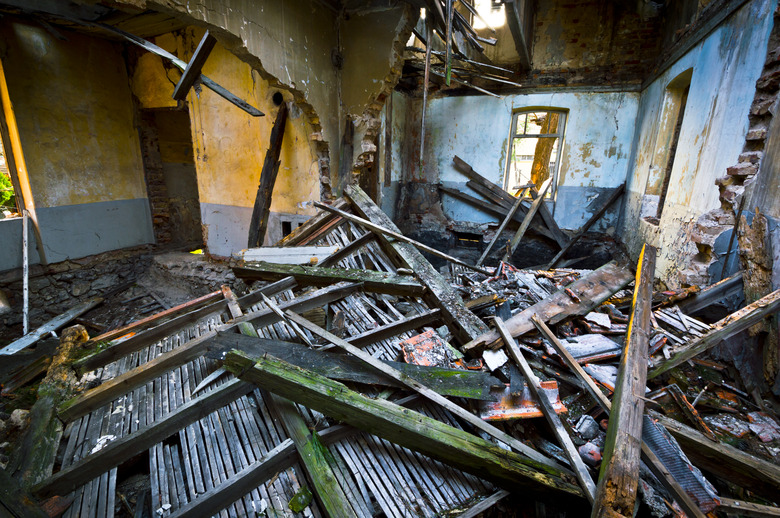Damage Caused By A Tornado
According to the National Weather Service, the United States experiences more than 1,200 tornadoes per year on average. The number of tornadoes per year has increased significantly since the 1980s when the National Weather Service began using Doppler Radar. Using observations and wind speed estimates, scientists can assess the damage caused by tornadoes to better understand these powerful storms and their destructive impact.
How Tornadoes Form
How Tornadoes Form
Tornadoes form from severe thunderstorms. Wind in the higher altitude of the storm moving at a greater velocity than wind at a lower altitude creates a vertical wind shear. The faster-moving winds aloft come from the west and create an updraft when they meet slower-moving wind close to the ground that is moving in the opposite direction. As warm surface air moves upward into the thundercloud, the rotating air creates a vortex.
Wind Speed and Air Pressure
Wind Speed and Air Pressure
Tornado damage is determined by the correlation between wind speed of the vortex and the difference in atmospheric pressure between the tornado and the surrounding air. Greater wind speed coupled with a large disparity in air pressure results in higher magnitude of damage. Strong winds pick up smaller, more mobile objects and move them, and can knock down smaller structures. The lower pressure within the tornado wreaks havoc on larger structures by creating a pressure differential between the exterior and interior of the structure. The extremes in air pressure tear roofs off buildings and demolish walls.
The First Scale
The First Scale
The original Fujita Scale (FS) was developed in 1971 to categorize the strength of tornadoes based on the observed level of damage they inflicted. The categories ranged from F0, light damage, to F5, incredible damage. It assigned estimated wind speeds to each category that corresponded to a particular threshold of damage. Because the wind speeds associated with each category were estimates, they could not be scientifically verified.
New and Improved Scale
New and Improved Scale
The FS was helpful, but it had its shortcomings. Tornadoes were categorized solely on observed damage they caused regardless of the type of structure that was damaged. Also, the simple descriptions of damage made it difficult to classify a tornado if it did not encounter the types of buildings or objects described in each category. Data gathered using the FS contributed to the development of an improved version that shows a more accurate correlation between wind speed and damage.
Since 2007, the National Weather Service has used the Enhanced Fujita Scale (EF) to rate tornadoes. The EF still conforms to the six-category system (F0-F5) of the FS but includes several enhanced features. The description of damage for each category has been replaced with a more detailed Degree of Damage (DOD). A set of 28 Damage Indicators (DI) provide additional data for classifying tornadoes. DI stipulate details about specific structures such as building type, square footage, roof structure and building materials, all data that is absent from the FS. And while the EF still relies on wind speed estimates, combined data from the observed DOD and DI make the estimates more accurate.
Degree of Damage
Degree of Damage
The damage descriptions used by the EF include more details than the FS and include photos and specific examples of damage. The DOD also assesses damage incurred by trees in addition to structural damage. The DOD for a category F0 tornado includes damage to gutters and siding, broken tree branches and uprooting shallow trees. Wind gusts are less than 86 mph. F1 tornadoes can rip off doors, break windows and upend mobile homes. Above 110 mph, F2 tornadoes can tear off roofs, uproot or snap large trees pick up cars and destroy mobile homes. A category F3 does major damage to malls, throws heavy cars and can destroy entire floors of homes. Gusts 166 mph and greater are associated with F4 tornadoes, which can create missiles out of objects hurtled at great speeds. A category F5 tornado, with wind gusts greater than 200 mph, has the potential to inflict severe damage that may include leveling well-built houses, destruction of concrete buildings and buckling high-rise structures.
Cite This Article
MLA
Mentzer, A.P.. "Damage Caused By A Tornado" sciencing.com, https://www.sciencing.com/damage-caused-tornado-5529386/. 11 April 2018.
APA
Mentzer, A.P.. (2018, April 11). Damage Caused By A Tornado. sciencing.com. Retrieved from https://www.sciencing.com/damage-caused-tornado-5529386/
Chicago
Mentzer, A.P.. Damage Caused By A Tornado last modified March 24, 2022. https://www.sciencing.com/damage-caused-tornado-5529386/
